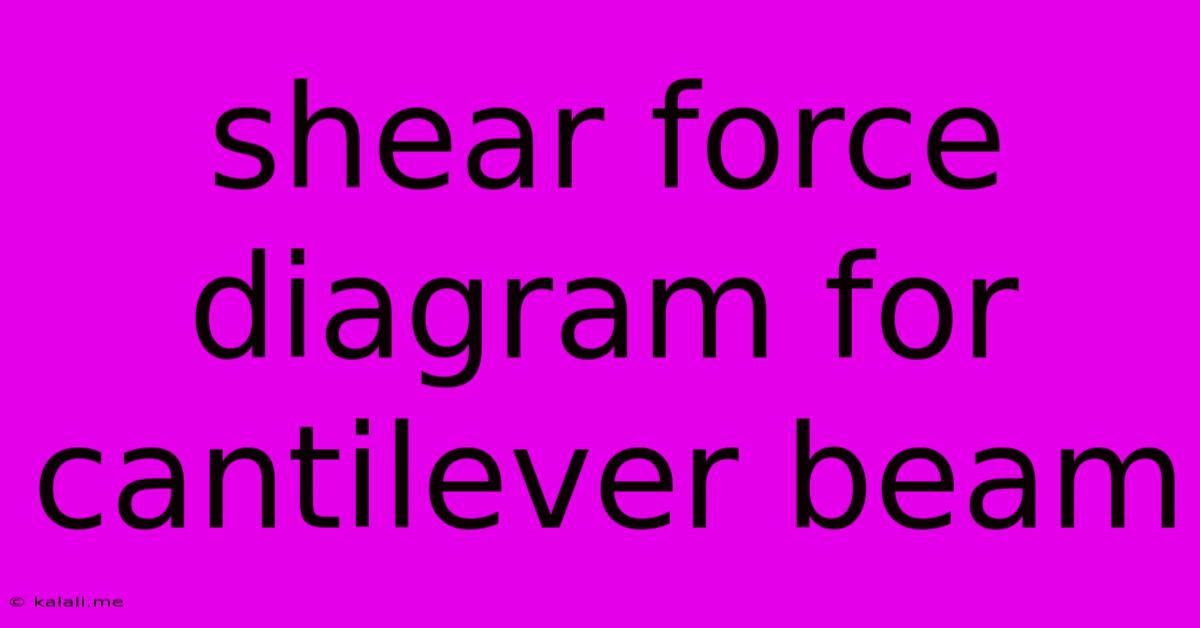Shear Force Diagram For Cantilever Beam
Kalali
Jun 14, 2025 · 4 min read

Table of Contents
Understanding Shear Force Diagrams for Cantilever Beams
Meta Description: Learn how to draw and interpret shear force diagrams (SFD) for cantilever beams. This comprehensive guide covers the fundamentals, steps, and examples to master SFD analysis. Understanding shear force is crucial for structural engineering and design.
A cantilever beam is a structural element fixed at one end and free at the other. Understanding its behavior under load is crucial in structural engineering. A key tool in this analysis is the shear force diagram (SFD). This diagram graphically represents the internal shear forces acting along the length of the beam. Mastering the creation and interpretation of SFDs for cantilever beams is essential for engineers and students alike. This article provides a clear, step-by-step guide to creating accurate and insightful SFDs.
What is a Shear Force?
Before diving into diagrams, let's define shear force. Shear force is the internal force within a beam that acts parallel to the cross-section, resisting the tendency of one part of the beam to slide past the other. It's a consequence of external loads applied to the beam. Understanding these internal forces is key to ensuring structural integrity.
Steps to Draw a Shear Force Diagram for a Cantilever Beam
Drawing an SFD involves a systematic approach. Here's a step-by-step process:
-
Identify the Support Reactions: For a cantilever beam, the fixed end (the wall) provides a vertical reaction force (R) and a moment reaction (M). The free end has no support reactions.
-
Determine the Sign Convention: A common convention is upward forces as positive and downward forces as negative. Moving from left to right along the beam, a positive shear force indicates upward shear, while a negative shear force indicates downward shear.
-
Draw the Free Body Diagram: This is a crucial step. Sketch the beam, clearly indicating all external loads (concentrated loads, uniformly distributed loads, etc.) and the support reactions.
-
Section the Beam: Imagine cutting the beam at various points along its length. This allows you to analyze the internal shear forces at different locations.
-
Analyze Shear Force at Each Section: For each section, consider the equilibrium of forces. The algebraic sum of the vertical forces to the left (or right) of the section must equal the shear force at that point.
-
Plot the Shear Force: Plot the shear force values against the corresponding locations along the beam's length. This creates the SFD. The diagram will show how shear force varies along the beam.
Example: Cantilever Beam with a Concentrated Load
Let's consider a cantilever beam of length 'L' subjected to a concentrated load 'P' at the free end.
-
Support Reactions: The fixed end will have a vertical reaction force R = P (upward) and a moment reaction M (counter-clockwise).
-
Free Body Diagram: Draw the beam with the load 'P' at the free end and the reaction force 'P' at the fixed end.
-
Sectioning: If we consider a section at a distance 'x' from the fixed end, the shear force at that section will be simply 'P' (constant along the whole beam length because there are no other loads to consider).
-
SFD: The SFD will be a horizontal line at a value of 'P' (negative because it acts downwards based on the sign convention) from the fixed end to the free end.
Example: Cantilever Beam with a Uniformly Distributed Load
Consider a cantilever beam of length 'L' with a uniformly distributed load (UDL) 'w' (force per unit length).
-
Support Reactions: The fixed end will have a vertical reaction force R = wL (upward) and a moment reaction.
-
Free Body Diagram: Draw the beam with the UDL acting along its length and the reaction force wL at the fixed end.
-
Sectioning: At a distance 'x' from the fixed end, the shear force will be equal to wx (negative). This is because the UDL acts downwards and the shear force is the sum of all vertical forces to the left of the section.
-
SFD: The SFD will be a linearly varying line, starting at 0 at the free end and reaching -wL at the fixed end.
Interpreting Shear Force Diagrams
The SFD provides valuable information:
- Maximum Shear Force: Identifies the location and magnitude of the maximum shear force within the beam. This is crucial for structural design as it indicates the point of highest stress.
- Points of Zero Shear: Indicates points where the shear force changes sign. These points are often locations of maximum bending moment.
- Shear Stress: Shear force is directly related to shear stress, which is the force per unit area resisting shear deformation.
Understanding shear force diagrams is essential for safe and efficient structural design. By systematically following the steps outlined above, you can accurately analyze the internal forces within cantilever beams and ensure their structural integrity.
Latest Posts
Latest Posts
-
What Is The Unit Of Resistivity
Jun 15, 2025
-
1 Is Subtracted From A Number
Jun 15, 2025
-
What Is The Factor Of 88
Jun 15, 2025
-
My Best Vacation Essay 250 Words
Jun 15, 2025
-
Match The Following Market Modification Methods With The Correct Example
Jun 15, 2025
Related Post
Thank you for visiting our website which covers about Shear Force Diagram For Cantilever Beam . We hope the information provided has been useful to you. Feel free to contact us if you have any questions or need further assistance. See you next time and don't miss to bookmark.